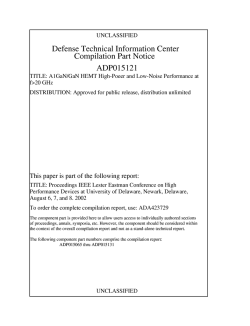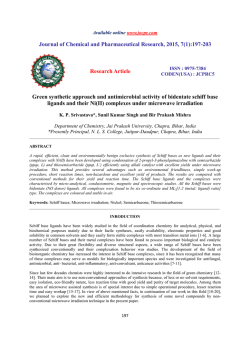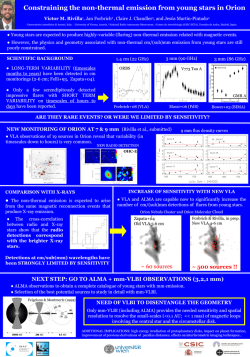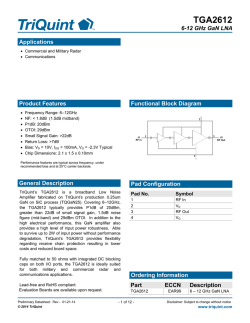
Variable Frequency Microwave (VFM)
Applications of Fixed and Variable Frequency Microwave (VFM) Facilities in Polymeric Materials Processing and Joining H S Ku, PhD Candidate, Industrial Research Institute, Swinburne, Swinburne University of Technology (SUT); Faculty, University of Southern Queensland, Australia. F Siu, PhD Candidate, Industrial Research Institute, Swinburne, Swinburne University of Technology, Melbourne, VIC 3122, Australia. E Siores, Professor and Executive Director, Industrial Research Institute Swinburne (IRIS), Swinburne University of Technology (SUT), Melbourne, VIC 3122, Australia. J A R Ball, A/Prof & Head, Electrical, Electronic & Computer Engineering, University of Southern Queensland (USQ), West Street, Toowoomba, 4350 Australia. Abstract Microwave processing of materials is a relatively new technology advancement alternative that provides new approaches for enhancing material properties as well as economic advantages through energy savings and accelerated product development. Factors that hinder the use of microwaves in materials processing are declining, so that prospect for the development of this technology seem to be very promising (Sutton, W.H., 1989). The two mechanisms of orientation polarisation and interfacial space charge polarisation, together with dc. conductivity, form the basis of high frequency heating. Clearly, advantages in utilising microwave technologies for processing materials include penetrating radiation, controlled electric field distribution and selective and volumetric heating. However, the most commonly used facilities for microwave processing materials are of fixed frequency, eg 2.45 GHz. This paper presents a state-of-the-art review of microwave technologies, processing methods and industrial applications, using variable frequency microwave (VFM) facilities. This is a new alternative for microwave processing. The technique is geared towards advanced materials processing and chemical synthesis. It offers rapid, uniform and selective heating over a large volume at a high energy coupling efficiency. This is accomplished using a preselected bandwidth sweeping around a central frequency employing frequency agile sources such as travelling wave tubes as the microwave power amplifier. Selective heating of complex samples and industrial scale-up are now viable. During VFM processing, a given frequency of microwaves would only be launched for less than one millisecond. Two facilities were employed during the study. The VW1500 (Figure 1) with a maximum power output of 125 W generates microwave energy in the frequency range of 6 – 18 GHz and the other, Microcure 2100 Model 250 (Figure 2) operates at 6 – 18 GHz with a maximum power level of 250 W. The cavity dimension of VW1500 (Figure 1) was 250 mm x 250 mm x 300 mm and the Microcure 2100 model 250 has a cavity size of 300 mm x 275 mm x 375 mm. Successful applications of the VFM technology are in the areas of curing advanced polymeric encapsulants, thermoplastic matrix composite materials characterisation, adhesive characterisation, rapid processing of flip-chip (FC) underfills, joining reinforced thermoplastic matrix composites materials, and structural bonding of glass to plastic housing. However, there are a lot of factors that have to be considered before employing variable frequency microwave (VFM) irradiation for processing materials. Not all materials are suitable for microwave processing and one has to match the special characteristics of the process. Blind applications of microwave energy in material processing will usually lead to disappointment. On the other hand, wise application of the technology will have greater benefits than have been anticipated. Successful applications of these modern facilities by the authors include the characterisation of glass or carbon fibre reinforced thermoplastic matrix composites, eg 33% by weight glass fibre reinforced low density polyethylene [LDPE/GF (33%)], of primers eg two-part five-minute rapid araldite (LRA), and joining of the above mentioned composite materials with, or, without primers. Such applications are detailed in this paper. Keywords: Variable frequency microwave (VFM) facilities, characterisation, fibre reinforced thermoplastic matrix composite materials, bulk heating and penetrating radiation. 1. Introduction The word microwave is not new to every walk of life as there are more than 60 million microwave ovens in households all over the world (NRC, 1994). On account of its great success in processing food, people believe that the microwave technology can also be wisely employed to process materials, eg cross-link polymers or sinter ceramics. Microwave processing of materials is a relatively new technology that provides new approaches Figure 1.: Cavity Size of VW1500 In conventional microwave processing, microwave energy was launched at a fixed frequency of either 915 MHz or 2.45 GHz or 5.8 GHz or 24.125 GHz into a waveguide or cavity and it brought with it the inherent heating uniformity problems like hot spots and thermal runaway (Thuery, J., 1992; Lambda Technology, undated; Liu, F. et al, 1996; Ku et al, 2000d). A US based company developed a new technique for microwave processing, known as variable frequency microwave (VFM) technique, to solve the problems brought about by fixed frequency microwave processing. The technique was geared towards advanced materials processing and chemical synthesis. It offered rapid, uniform and selective heating over a large volume at a high energy coupling efficiency. This was accomplished using preselected bandwidth sweeping around a central frequency employing frequency agile sources such as travelling wave tubes as the microwave power amplifier. Selective heating of complex samples and industrial scale-up are now viable (Liu, F. et al, 1996; Wei, J.B. et al, 1998; Ku et al, 2000d). Successful applications have been reported in the areas of joining fibre reinforced thermoplastic matrix composite materials, of curing advanced polymeric encapsulants, rapid processing of flip-chip underfills, materials characterisation, curing profiles for various adhesives, structural bonding of glass to plastic housing (Wei, J.B. et al, 1998; Anderson, B., et al, undated; Clemons, J., et al, undated; Fathi, Z., et al, undated; Ku et al, 2000d). 2. Microwave Fundamentals Figure 2: Cavity Size of Microcure 2100 to improve the physical properties of materials; alternatives for processing materials that are hard to process; a reduction in the environmental impact of materials processing; economic advantages through energy savings, space, and time; and an opportunity to produce new materials and microstructures that cannot be achieved by other methods. Microwave characteristics that are not available in conventional processing of materials consist of (NRC, 1994): penetrating radiation; controllable electric field distribution; rapid heating; selective heating of materials and self-limiting reactions. Single or in combination, these characteristics lead to benefits and opportunities that are not available in conventional processing methods. The mechanisms that govern the energy distribution process during microwave processing of materials include dipole friction, current loss and ion jump relaxation (Metaxas, R.C. and Meredith, R.J, 1983; Siores, E, 1994; Ku et al, 1997a; 2000d). This results in a relatively uniform heat distribution throughout the entire exposure to microwave irradiation, immediately in front of rectangular or circular waveguides. The fast heating rate encountered using microwave energy can thus lead to reduced processing time and consequent energy efficiency. Microwaves form part of a continuous electromagnetic spectrum that extends from low-frequency alternating currents to cosmic rays. In this continuum, the radio-frequency range is divided into bands as depicted in Table 1. Bands 9, 10 and 11 constitute the microwave range that is limited on the low-frequency side by HF and on the high-frequency side by the far infrared (Thuery, 1992). These microwaves propagate through empty space at the velocity of light. The frequency ranges from 300 MHz to 300 GHz (NRC, 1994). Frequencies reserved for industrial applications consist of 915 MHz, 2.45 GHz, 5.8 GHz and 24.124 GHz. Amongst those bands, 2.45 GHz is the most commonly used in industrial applications. Industrial microwaves are generated by a variety of devices such as like magnetrons, power grid tubes, klystrons, klystrodes, crossed-field amplifier, travelling wave tubes, and gyrotrons (NRC, 1994). Table 1: Frequency Bands Band Designation 4 VLF very low frequency 5 LF low frequency 6 MF medium frequency 7 HF high frequency 8 VHF very high frequency 9 UHF ultra high frequency 10 SHF super high frequency 11 EHF extremely high frequency Frequency limits 3 kHz - 30 kHz 30 kHz - 300 kHz 300 kHz - 3 MHz 3 MHz - 30 MHz 30 MHz - 300 MHz 300 MHz - 3 GHz 3 GHz - 30 GHz 30 GHz - 300 GHz At the customary domestic microwave frequency of 2.45 GHz, the magnetrons are the workhorse. Material processing (NRC, 1994) falls into this category. The material properties of greatest importance (Metaxas, A.C. and Meredith, R.J., 1983; Ku et al, 1997a; 1997b; 1998; 1999a; 1999c) in microwave processing of a dielectric are the complex relative permittivity ε = ε′ - jε″ and the loss tangent, tan δ = ε″/ ε′. The real part of the permittivity, ε′, sometimes called the dielectric constant, mostly determines how much of the incident energy is reflected at the air-sample interface, and how much enters the sample. The most important property in microwave processing is the loss tangent, tan δ or dielectric loss, which predicts the ability of the material to convert the incoming energy into heat. data, the bandwidth values most suitable for microwave processing were chosen. 5. Characterisation of TPC Materials from 2 GHz to 8 GHz The operation bandwidth for Microcure 2100 Model 250 is from 2 GHz to 8 GHz. Two-part five-minute rapid araldite (LRA) was characterised using a power of 50 W and the maximum temperature reached was 100oC. The percentage reflection against frequency of LRA was shown in Figure 5. The reflectance is the ratio of the reflected power to the 3. Microwave Processing Currently, in most industrial microwave processing operations, the frequency of the microwave irradiation is usually fixed. When microwave energy of a fixed frequency, eg 2.45 GHz was launched into a waveguide eg WR340, as depicted in figure 3(a), containing a piece of material, some areas of the material would experience higher electric field strength than the others; the situation would even be more serious if the microwave energy was launched into a multimode cavity because many resonant modes will be established. Figure 3(b) shows the fixed electric field pattern across any cross section of the joint of the test pieces during fixed frequency heating. Those areas with higher electric field strength would be heated more, creating hot spots, which could even lead to thermal runaway. With variable frequency microwave heating (Wei, J.B. et al, 1998; Ku et al, 2000c; 2000d), as shown in figure 4(a), more than one thousand frequencies were launched into the cavity sequentially. Each incident frequency set up its own electric field pattern across any cross section of the joint of the test pieces, and therefore resulted in hot spots at different locations at different time, as shown in figure 4 (b). Different areas were heated under different frequencies at different times. When a sufficient bandwidth was used, every element of the test piece would experience hot spots at one or more frequencies during sweeping. Therefore, time-averaged uniform heating could be achieved with proper adjustment of the frequency sweep rate and sweep range. This is a major advantage of VFM heating together with the capability of providing precise frequency tuning to optimise the coupling efficiency. A similar method but using a different approach has been reported Fathi et al, (undated). a) 2.45 GHz Microwave Energy launched into a Single Mode Applicator b) Electric Field patterns for (a) Figure 3: Fixed Frequency Microwave Heating – Nonuniform Heating 4. Characterisation of Thermoplastic Matrix Composite (TMC) Materials Using VFM The characterisation option of the VFM facilities was used to measure the characteristics of the cavity when a sample was loaded. The procedure followed was a sequence of operations whereby the user graphically sees how the cavity, with material loaded, would operate over the selected frequency range. The input power is selected on the basis of the estimated loss tangent of the material. The higher the estimated loss, the lower the power level selected. During characterisation of the loaded cavity, temperature variations were obtained as well as incident power and reflected power levels from the cavity containing the sample via a monitor. The incident and reflected power levels versus frequencies together with the percentage of reflectance against frequencies were monitored and recorded. From this a) Variable Frequency Microwave Energy Launched into Multi Mode Cavity STRENGTH (N) PS/CF(33%), 100W 800 600 400 200 0 60 80 100 120 TIME(S) Figure 6: Bond Strength of PS/CF (33%) with No Primer Using for Liquid Rapid Araldite (LRA) Variable Microwave Frequency b) Electric Field Pattern at Different Times in (a) Figure 4: Variable Frequency Microwave Heating – TimeAveraged Uniform Heating incident power, the lowest percentage of reflectance for the araldite was from 6.5 GH – 8 GHz and the best frequency range to process it is therefore from 6.5 to 8 GHz. 6. Joining of TPM Composite Materials The first experiment was conducted using 33% by weight carbon fibre reinforced polystyrene [PS/CF (33%)]. The best frequency to process this material using Microcure 2100, ie frequency range between 2 GHz to 8 GHz, was from 6.5 GHz to 8 GHz (Ku et al, 2000d). Since the material was processed with variable frequency sweep, it was necessary to identify the centre frequency for the sweep, which was found to be (6.5GHz + 8GHz) 2 = 7.25 GHz. Since the bandwidth of the sweep should be greater than 1.0 GHz, the selected bandwidth was 1.5 GHz (Lambda Technologies, 1998). The actual start and stop frequencies would be centre frequency ± bandwidth ie 2 the sweep would be from 6.5 GHz to 8.0 GHz. Because the sweep time could range from 0.1 second to 100 seconds, the chosen sweep time FREQUENCY (GHz) Figure 5: Percentage of Reflectance against Frequency 7.5596 6.9271 6.2947 5.6622 5.0298 4.3973 3.7649 3.1324 140 120 100 80 60 40 20 0 2.5 % OF REFLECTANCE CHARACTERISATION OF LIQUID RAPID ARALDITE, POWER 50 W was 0.1 second (Lambda Technologies, 1998). Each frequency is transmitted to the sample in a very short time, eg 20 µs (Ku et al, 2000d). Since the material loss tangent was relatively high, a power level of 100 W was selected (Lambda Technologies, 1998; Ku et al, 1999b; Ku et al, 2000a; Ku et al, o 2000b). The processing temperature was set at 95 C with a o deadband of 1 C and the total processing time was set at 60 seconds. The maximum permitted temperature was set at o 100 C, above that the machine was switched off automatically. This temperature was very near to the melting point of the matrix, the PS. The reason for setting this maximum temperature was to avoid excessive temperature rise, which forms hot spots and thermal runaway. The lapped area for the joint was 10 mm x 20 mm. The bond surfaces were also roughened with coarse, grade 80 emery paper. The roughened surfaces were then cleaned and degreased by immersing them in methanol. No araldite was applied. The two test pieces were then brought together and the total pressure applied was about 4 N. The process parameters were as follows: Variable Frequency = 7.25 GHz, bandwidth = 1.5 GHz, sweep time = 0.1 secs Power Output = 100 Watts Set Temp = 95 Degs C, 1 Degs C, duration = 60 seconds Maximum Temperature = 100 Degs C It was found that the temperature rose steadily with no sign of hot spots or thermal runaway. For obtaining tensile shear test results, several sets of test pieces were joined at different duration and details are discussed below. Figure 6 shows the bond strengths of PS/CF (33%) versus time of exposure. In tensile shear tests, all samples failed at the parent materials but their values were low as compared to the tensile strength of the original material. The load required to break the original materials was 1108 N. Since the strength of the joined material was significantly reduced, it appeared that the main reason for its weakness was due to the excessive exposure to microwave irradiation. It could therefore be argued that up to certain limits, a better strength of the joined material could be achieved by reducing the time of its exposure to microwave energy. On the other hand, joining the material by fixed frequency did not give satisfactory results as the carbon fibre arced in a short period of 7 seconds when exposed to a power level of 640 W. In addition, the quality of the bonds was poor. 7. Conclusion From the above discussions, it is evident that there are a lot of factors that have to be considered before employing microwave irradiation, whether it is of fixed or variable frequency, for processing materials. Not all materials are suitable for microwave processing and one has to match the special characteristics of the process. Blind applications of microwave energy in material processing will usually lead to disappointment. On the other hand, wise application of the technology will have greater benefits than have been anticipated. VFM processing offers greater rapid, uniform and selective heating over a large volume at a high energy coupling efficiency than its fixed frequency counterpart. References: Anderson, B., et al (undated), Rapid Processing and Properties Evaluation of Flip-Chip Underfills, http://www.microcure.com/papers.htm, pp. 1 – 9. Clemons, J., et al (undated), Characterisation and Numerical Modelling of Variable Frequency Microwave Processed Materials, pp. 1-8. Fathi, Z., et al (undated), Innovative Curing of High Reliability Advanced Polymeric Encapsulants, http://www.microcure.com/papers.htm, pp. 1 – 11. Ku, H.S., Siores E, and Ball J A R (1997a), Welding of Thermoplastic Composites Using Microwave Energy, Proceedings of CIPR International Symposium, Hong Kong, 21-22 August, Vol 2, 1997, pp 612-9. Ku, H.S., Siores, E., and Ball, J.A.R. (1997b), Weldability and Heat Affected Zone (HAZ) Evaluation of for High Energy Rate Joining of Thermoplastic Composites Using Microwave Energy, Proceedings of the Eleventh International Conference on Composite Materials, Gold Coast, Australia, Vol. VI, pp. 5564. Ku H S, Siores, E, Ball, J A R and Horsfiled, B (1998), An Important Step in Microwave Processing of Materials: Permittivity Measurements of thermoplastic Composites at Elevated Temperatures, Proceedings of 1998 Pacific Conference on Manufacturing, Brisbane, Australia, August 18 - 21, pp. 68-73. Ku, H S, Siores, E, Ball, J A R and Horsfiled, B (1999a), Microwave Processing and Permittivity Measurement of Thermoplastic Composites at Elevated Temperatures, Journal of Materials Processing Technology, Vol 89-90, May, pp. 419-24. Ku, H S, Siores, E, Ball, J A R and Chan, P (1999b), Complex Permittivity of Low Loss Thermoplastic Composites Using a Resonant Cavity Method, Proceedings of ICCM-12 in CD ROM, Theme: NDT & Reliability; Others, Paris, France, 5th 9th July. Ku, H S, Siores, E, Taube, A and Ball, J A R (1999c), Productivity Improvements Through the Use of Industrial Microwave Technologies, Proceedings of the 26th International Conference on Computers and Industrial Engineering, 15th – 17th December, Melbourne, Australia, pp. Ku, H.S., Ball, J.A.R., Siores, E. and Horsfield, B. (2000a), Permittivity Measurement of Thermoplastic Composites at Elevated Temperature, Journal of Microwave Power and Electromagnetic Energy (submitted for publication). Ku, H.S., Ball, J.A.R., Siores, E. and Chan, P. (2000b), Dielectric Loss for Low Loss Thermoplastic Composites Using a Resonant Cavity Method, Journal of Microwave Power (submitted for publication). Ku, H.S., MacRobert, M., Siores, E. and Ball, J.A.R. (2000c), Characterisation of Thermoplastic Matrix Composites (TPC) Using Variable Frequency Microwave (VFM), Plastics, Rubber and Composites (submitted for publication). Ku, H S, Siores, E, Ball, J A R (2000d), Variable Microwave Processing of Thermoplastic Composites, Plastics, Rubber and Composites, pp. Lambda Technologies Inc. (1998), Operator’s Manual for Microcure 2100, Models 250, 700 and, pp. 2.1-3, 3.1-3, 4.1-10, 4.15-24, 4.30-33. Lambda Technology (undated), What is Variable Frequency Microwave Processing? http://www.microcure.com, pp. 1 – 2. Liu, F., et al (1996), A Numerical and Experimental Investigation of the Microwave Heating of Polymer Materials Inside a Ridge Waveguide, Journal of Microwave Power and Electromagnetic Energy, Vol. 31, No. 2, pp. 71 – 82. Metaxas, R.C. and Meredith, R.J. (1983), Industrial Microwave Heating, Peter Peregrinus Ltd., pp.5-6, 28-31, 43, 278. National Research Centre (NRC) (1994), Microwave Processing of Materials, National Materials Advisory Board, Commission on Engineering and Technical Systems, National Academy Press, USA, pp.1-7, 11-2, 100, 105. Siores, E. (1994), Microwave Technology for Welding and Joining, Materials World, Vol. 2, No. 10, p.526. Sutton, W.H. (1989), Microwave Processing of Ceramics, Ceramic Bulletin, Vol. 68, No. 2, pp. 376-86. Thuery, J. (1992), Microwaves: Industrial, Scientific and Medical Applications, Artech House, Inc., pp. 159-380. Wei, J.B., et al (1998), Industrial Processing Via Variable Frequency Microwaves Part I: Bonding Applications, Journal of Microwave Power and Electromagnetic Energy, Vol. 33, No. 1, pp.10 – 17.
© Copyright 2025




